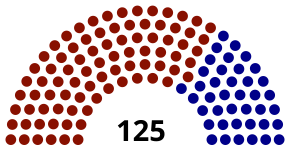Kansas House of Representatives
| Kansas House of Representatives | |
|---|---|
| Kansas State Legislature | |
 |
|
| Type | |
| Type | |
|
Term limits
|
None |
| History | |
|
New session started
|
January 9, 2017 |
| Leadership | |
|
Speaker pro Tempore
|
|
|
Majority Leader
|
|
|
Minority Leader
|
|
| Structure | |
| Seats | 125 |
 |
|
|
Political groups
|
Governing party
Opposition party
|
|
Length of term
|
2 years |
| Authority | Article 2, Kansas Constitution |
| Salary | $88.66/day + per diem |
| Elections | |
|
Last election
|
November 8, 2016 (125 seats) |
|
Next election
|
November 6, 2018 (125 seats) |
| Redistricting | Kansas Reapportionment Commission |
| Meeting place | |
| House of Representatives Chamber Kansas State Capitol Topeka, Kansas |
|
| Website | |
| Kansas House of Representatives | |
Governing party
Opposition party
The Kansas House of Representatives is the lower house of the legislature of the U.S. state of Kansas. Composed of 125 state representatives from districts with roughly equal populations of at least 19,000, its members are responsible for crafting and voting on legislation, helping to create a state budget, and legislative oversight over state agencies.
Representatives are elected to a two-year term. The Kansas House of Representatives does not have term limits. The legislative session convenes at the Kansas State Capitol in Topeka annually.
On January 29, 1861, President James Buchanan authorized Kansas to become the 34th state of United States, a free state. The ratification of the Kansas Constitution created the Kansas House of Representatives as the lower house of the state legislature.
Members of the Kansas House voted to impeach Governor Charles L. Robinson in 1862, but the impeachment trial did not lead to his conviction and removal of office. The Kansas Senate did vote to impeach the secretary of state and state auditor for the unlawful sale of bonds, but only three state senators voted for the governor's impeachment.
In 1870, the Kansas House of Representatives first met at the Kansas State Capitol, which was not officially completed until 1903.
Populists and Republicans both claimed control of the Kansas House of Representatives in 1893, with the Populists accusing the Republican Party of election fraud. The dispute led to separate Populist-led and Republican-led Houses in 1893 until the Kansas Supreme Court sided with the Republicans and the Populist-led House disbanded.
In 1918, Minnie J. Grinstead became the first female elected to the House.
In 1966, the state legislature began to hold annual general sessions and a constitutional amendment adopted at the 1974 general election extended the duration of the session held in the even-numbered years to 90 calendar days, subject to extension by a vote of two-thirds of the elected membership of each house.
...
Wikipedia
